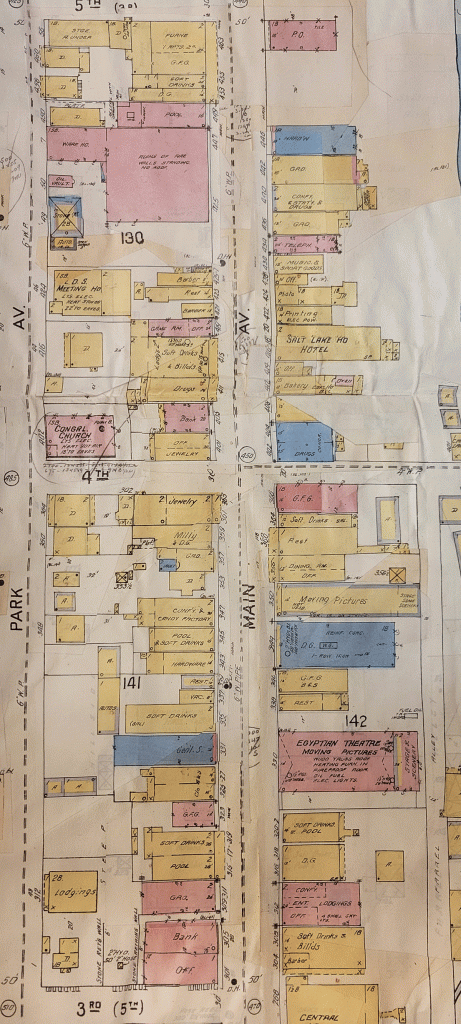This is the sixth article in a series on Prohibition in Park City.
“Ever since Prohibition went into effect so called ‘soft drink parlors’ and pool rooms have been a menace to communities because of unscrupulous men securing licenses for the sole purpose of violating the law by selling intoxicating liquors,” the Park Record reported in July of 1921. This comment was in response to the mayor temporarily closing soft drink parlors and pool halls and suspending approval of any new licenses for those types of businesses. Soft drink parlors were defined in city ordinance as “a place of business devoted chiefly to the dispensing and sale of tobaccos, confectionary, and non-alcoholic drinks to be consumed on the premises.” The ordinance also noted the mayor could close down any parlor being operated “in a disorderly manner.”
By August 1921, however, many of the places were reopened by order of City Council. According to the Park Record, new licenses from reputable businessmen were denied but the reopened establishments were run by less than reputable gentlemen. They noted that if the city was going to let the lawbreakers reopen, they should at least be fair and let the other businesses open. They added they would like to see a provision added to all licenses for soft drink parlors and pool halls setting an expectation of fines and arrests at regular intervals that would at least replenish City coffers. They also made sure to admonish patrons of the lawbreaking parlors, calling them “poor perverted dupes.”

Credit: Park City Historical Society & Museum, Sanborn Fire Insurance Map Collection
The newspaper’s frustration continued into the following year. In March 1922 they called the Prohibition law a “farce.” They added to that sentiment in May, writing that the law was “nothing but a farce-comedy.” In June, they commented that “we know not whether the so-called Prohibition law has made any angels, but we do know that it has millions of lawbreakers and corrupted thousands of officers elected and appointed to enforce the law.”
Park City did have federal raids of lawbreaking soft drink parlors in June and September of 1922, but a federal investigation in June noted that Park City was “no worse” than any other Utah cities.
The police and federal agents continued to make raids of parlors. In 1924, one raid at the Palace on upper Main Street resulted in no arrests because, while an officer had seized a jug of moonshine sitting out on the bar, since he had not witnessed a sale, it was not illegal to just have the alcohol in the parlor. Only selling it could result in arrests for a bartender. The Park Record griped that this instance, “if true, only proves the absurdity of the liquor law and makes a laughingstock of those paid to enforce it.”
In the first three months of 1924 alone, federal Prohibition agents seized and destroyed about 9,000 gallons of moonshine, whiskey, and wine; seized 22 manufacturing locations and stills; confiscated two automobiles; and made 55 arrests in Utah. None of that was in Summit County or Park City, which yet had more than its fair share of lawbreakers. The Park Record reported “it was known” that 98% of soft drink parlors in Park City were serving liquor.
Prohibition comes to a close in the next article. Watch the Museum’s most recent lecture – about Prohibition – on their YouTube Channel. Dalton Gackle is giving a lecture about general Park City life and mining history on June 22 from 5 to 6 p.m. at the Museum’s Education and Collections Center at 2079 Sidewinder Drive. Register here.
Sources:
“The Closing of Soft Drink Places.” Park Record, July 8, 1921.
“An Ordinance.” Park Record, March 7, 1924.
“The Soft Drink Joke.” Park Record, August 12, 1921.
“Mike Sheehan Caught with Goods.” Park Record, March 3, 1922.
“The Farce Comedy Called Prohibition.” Park Record, May 5, 1922.
“General Items.” Park Record, June 30, 1922.
“Federal Officers Make Arrests.” June 23, 1922 and “Federal Officers Make Raid on Drink Parlors.” September 29, 1922.
“The Stroller Notices.” Park Record, June 30, 1922.
“Another Soft Drink Parlor Closed.” Park Record, February 29, 1924.
“Federal Officers Doing Good Work.” Park Record, April 4, 1924.
“Police Court.” Park Record, March 19, 1926.